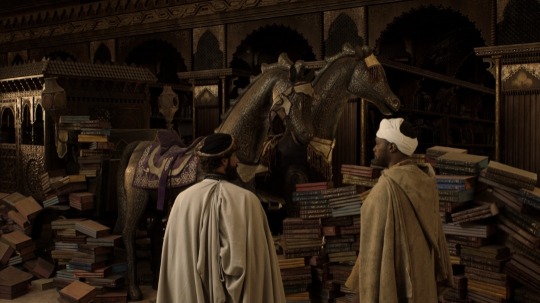#domingo badía i leblich
Explore tagged Tumblr posts
Text
@asongofstarkandtargaryen I found another interesting film to watch. I'm used to do an upcoming films/series section, but this time it will be a little different.
In this case, this is a film from 2019, it's a period drama directed by Souheil Ben-Barka, and it's a co-production between Morocco and Italy, De sable et de feu (Sabbie e fuoco in Italian, Sand and Fire in English, and in Spanish the film is either called El sueño del califa or El sueño envenenado).
It's difficult to found the film, it isn't available in any streaming platform and I have been looking for it online and I haven't found it yet.

youtube
(This is the English version of the trailer, for the French and the Spanish ones, click in here and here)
The film Sand & Fire (The impossible Dream) tells the story of Domingo Badía i Leblich, alias Ali Bey al Abbassi (April 1st 1767, Barcelona -August 30th 1818, Damascus) and Lady Hester Stanhope, otherwise known as Meleki, Queen of Palmyra, (May 12th 1776 Kent, England - 1839 Djîhoun). Set between 1802 and 1818, the plot of the film has resonance for today with searing realism as it depicts a moderate peaceful Islam confronting another which is fanatical and cruel.
Domingo Badia was a Catalan scientist militar, traveler and Arabist, who in 1803, was commissioned by Manuel Godoy (prime minister of Charles IV of Spain) to undertook a long journey through Muslim territories, camouflaging him as a Syrian prince descendant of the Abbasids, Ali Bey al Abbassi, son of the Emir of Damascus (assassinated by the Otomans).
On the previous tears in Córdoba around 1795 he had been working on his project of the construction of a hot air balloon that he planned to use to carry out atmospheric observations (height of the atmosphere in relation to sea level, atmospheric pressure, heat and humidity), although after several attempts the project did not end with good results.
His travels took him to Morocco, Algeria, Libya and various regions of the Ottoman Empire (Egypt, Arabia, Syria, Turkey and Greece), which he would describe in the book The Travels of Ali Bey, in which along with detailed descriptions of the cities he visited, recorded his observations on geography, botany, zoology, entomology, geology and meteorology.
Although in fact, he was a secret agent with a mission to gain the trust of the Moroccan Sultan, Moulay Slimane and trying to convince him to accept a proposal to stablish the sultanate as a protectorate under the Spanish rule. By then, Badía was conspiring against the sultan, conducting extensive negotiations with the chiefs of the rebellious tribes, to destabilize the sultanate's government and overthrow the sultan, who was suspect of broking his neutralilty and ally with the English against Spain in the context of the Anglo-Spanish War (1804-1809), but the plan failed and Moulay Slimane expelled Ali Bey from the country.
Apart from his travels and his missions in Morocco, during the Napoleonic invasion he acted as mayor of Segovia and prefect of Córdoba between 1809 and 1811 under the rule of Joseph I of Spain.
Within this time period, Richard Brothers (well known for his extremely detailed prediction of the beheading of Louis XVI of France) revealed in a book that Lady Hester Stanhope, niece of the English Prime Minister, William Pitt, would be crowned Queen of Palmyra, the new Zenobia.
Lady Hester was a British aristocrat, but also an adventurer, antiquarian, and one of the most famous travellers of her age. Her archaeological excavation of Ashkelon in 1815 is considered the first to use modern archaeological principles, Her letters and memoirs made her famous as an explorer. She traveled to several places of the Ottoman Empire like Athens, Rhodes, Constantinople, the Ionian Islands, the Peloponnese, Athens, Malta, Constantinople, Rhodes, Egypt, Palestine, Lebanon and Damascus and Jerusalem.
On April 14, 1813, Lady Hester made the decision to charter a caravan of 50 camels, a large retinue of servants and dressed in splendid clothes in the manner of a Druze prince, also hiring a group of armed and uniformed Bedouins as Praetorian Guard. Lady Hester pretended to imitate the mythical queen Zenobia who defied the Romans. On March 29, 1813, the procession arrived at the city of Palmyra, which was splendidly received by the Bedouins. Lady Hester Stanhope earned the admiration and respect of the local Bedouin tribes, who called her Maliki or the White Queen of Tadmir (Palmyra).
Domingo Badia meets Lady Hester when he goes to London on a mission. It is the starting point of a passionate tumultuous love affair which endures for fourteen years before its tragic end; their love unable to sustain two irreconcilable visions of Islam.
Badía died in Damascus in 1818, it is said that he was poisoned by a British agent or that the British ordered to poison him, due to some of his actions during his secret misions were unfavorable for the British, it's said that probably Badía was in a secret mission by that time. Previously he had already frustrated some interventions by the English, such as in 1806 when Badía sabotaged the British plan to remove Mehemet Ali and install their puppet Elfi Bey as pasha of Egypt or when in 1807 in Syria he discovered and destroyed a secret line that the English had to communicate with India.
A film-goer, travelling with Ali Bey through Spain, France, England and Morocco, is transported to sumptuously decorated palaces in Madrid, Paris, London and Morocco of the early 19th century and with Lady Hester to the burning sands of Arabia and the ancient ruins of Palmyra.
The film was shot in Italy, Morocco and England, and it lasts 115 minutes.
After a long absence, Souhail Ben-Barka returned to filmmaking. His career is rich in many films that have marked the history of Moroccan cinema, including the film “Amok” which has won many awards, in addition to his masterpieces “The Battle of the Three Kings”, “The Curse of the Pharaoh” and “The Lovers of Mogador”.
Director's note
I have always had freedom of choice concerning the topics and characters of all my previous films. For this one, I feel designated - as if it has chosen me… With his accomplished seduction, no one can resist the charms of the trickster, The figure full of charisma and mischief, but also the taste for conquest and bluffing of Badia /Ali Bey: From the most humble subjects to the grandest dignitaries, from the Sultan Moulay Slimane, to Lady Hester, Queen of Palmyra, to Napoleon himself who enquires of Talleyrand:
"Your man - is he genius or a madma.?" To which Talleyrand answers.
"A subtle combination of both, Sire. Great men are made that way."
Cast
Rodolfo Sancho (Domingo Badía i Leblich, aka Ali Bay al Abbassi)
Carolina Crescentini (Lady Hester Stanhope, aka Meleki)
Marisa Paredes (Lady Williams)
Giancarlo Giannini (Talleyrand)
Imanol Arias (Sultan Moulay Slimane/ Sulayman of Morocco)
Omar Azzuzi
Massimo Ghini (Amoros)
Marco Bocci (Manuel Godoy)
Abdelaziz Bouzaoui
Younés Kerkour
Hamid Basket
Kamal Moummad (Salem)
Ulisse Provolo (Dott. Blizzard)
Christo Jivkov (Mulai Driss)
Jean-Pierre André Douay
Emanuele Vezzoli (Firmin Didot)
Enrico Salimberi (Napoleon Bonaparte)
Creative staff
Director: Souheil Ben-Barka
Story and Screenplay : Bernard Stora and Souheil Benbarka
Executive Producers: Gianni Sarago and Hamid Basket
Art Director: Amal El Mazouni
Production Designer: Marco Trentini, Francesco Cotone
Director of Photography: Ugo Menegatti
Chief Make Up Artist: Leila Benbarka
Costume Supervisor: Lia Morandini
Music by: Stefano Lentini
Production: Co-production Morocco-Italy: Jal's Production (Casablanca) and Flat Parioli SRL (Rome).
Official website: http://www.desableetdefeu.fr/
Facebook









(I have found more pics about the film, but for thid post these are enough)
#de sable et de feu#sabbie e fuoco#sand and fire#el sueño del califa#el sueño envenenado#souheil benbarka#films#period dramas#rodolfo sancho#giancarlo giannini#carolina crescentini#marisa paredes#imanol arias#halid basket#omar azzouzi#marco bocci#massimo ghini#abdelaziz bouzaoui#kamal moummad#younés kerkour#christo jivkov#ulisse provolo#jean-pierre andré douay#domingo badía i leblich#ali bey al abbassi#hester stanhope#meleki of palmyra#slimane of morocco#sulayman of morocco#manuel godoy
9 notes
·
View notes